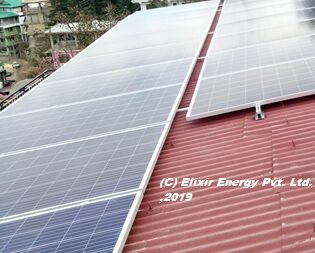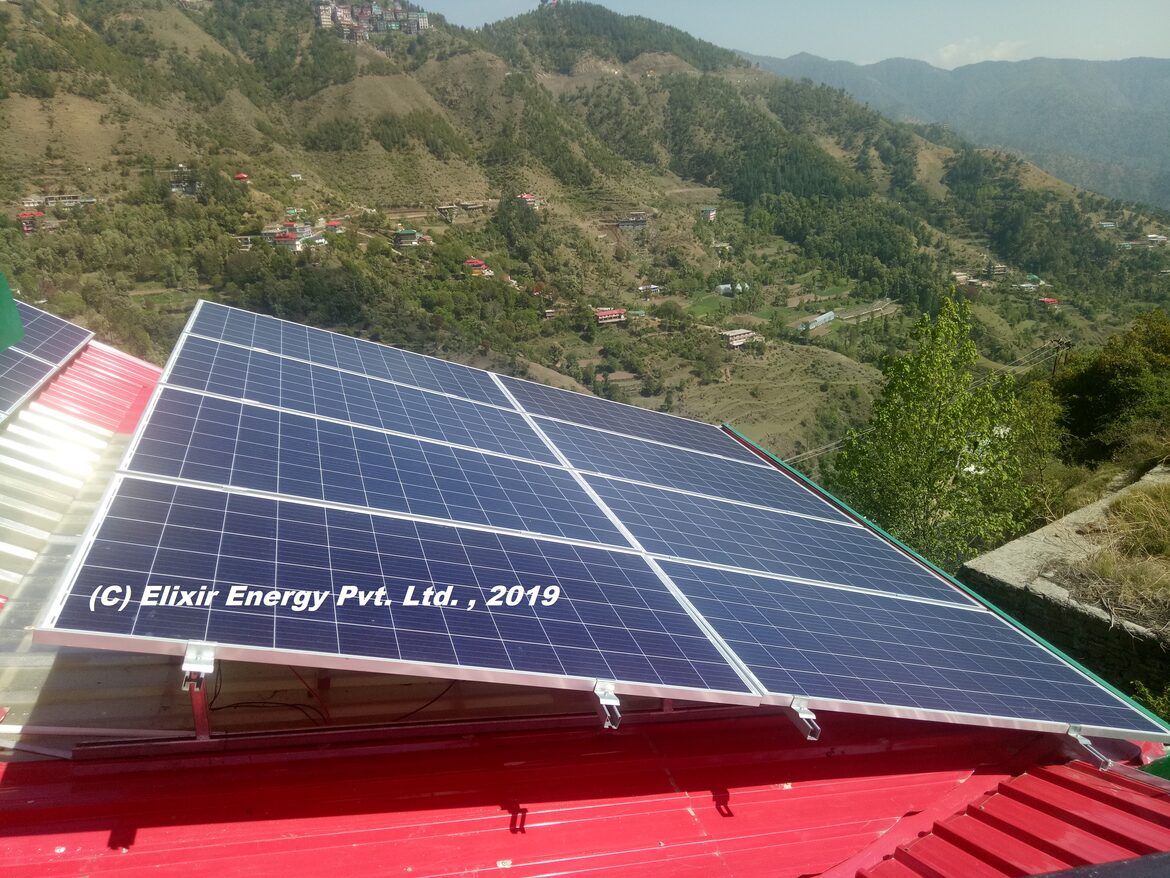Elixir Energy Commissions a 5 kW solar PV Plant in Shimla.


Elixir Energy Commissions a 5 kW solar PV Plant in Shimla.

Elixir Energy Pvt. Ltd. installed a 10 kW rooftop solar plant at a research institute in Hamirpur, H.P. demonstrating strong in-house EPC capabilities of the company. Adding another project to its portfolio.
. 
Elixir Energy Pvt. Ltd.'s Projects Team installed a 5 kWp Photovoltaic Power Plant in Shimla. The system is generating >20 kWh per day and the customer acknowledges the benefits and quality of the installation.

Elixir Energy commissions a 2 kWp solar rooftop plant in Shimla. The system demonstrates the application of high-efficiency multi-crystalline photovoltaic modules and on-grid inverters with net metering. The system is designed to be monitored at module-level, a capability which is absent in most PV plants.

What is the potential of the Sun and what are we doing with it?
Solar energy is one of the most promising sources of renewable energy and has been widely adopted worldwide as an alternate source of power generation. Theoretical potential of the solar energy falling on the earth is 89,300 TW or 480 Exa-Joules in one and a half hour which is greater than the worldwide energy consumption in 2001 (430 EJ). India has seen rapid increase in solar installations since 2010 and is now over 20 GW as on February 2018. Solar energy is harnessed using two major technologies namely solar thermal and photovoltaics. Solar thermal based systems utilize insolation by means of large collectors or concentrators to heat fluids and operate turbines for power generation whereas photovoltaic systems use solar cells to directly produce electricity from solar radiation without the use of turbines or any mechanically moving part (except in case the of solar trackers which is anyway an optional choice to adopt). Hence, photovoltaic systems are much simpler and easier to install and operate as compared to solar thermal systems and presently with a rapid decline in the costs of solar panels, is the preferred technology amongst project developers. Historic low tariffs for solar (INR 2.44 per kWh) and wind (INR 2.64 per kWh) has been achieved in 2018 which indicates that solar energy has already reached parity with thermal counterparts (e.g. NTPC sells energy from coal based plants at INR 3.20 per kWh). The solar energy system installation is likely to increase steadily in the next decade.
Adoption of solar and other renewable energy sources is globally acknowledged.
Renewable energy sources provide a means to generate energy without the emission of any pollutants. Global warming phenomenon has raised concerns over the sustainability of a healthy eco-system and life on earth. Not only the conventional methods of power generation emit a large volume of pollutants in the atmosphere but also the fuel reserves are on a steady rate of depletion. Hence in order to fuel the growth of economies of the world, meeting the growing energy demand and continual development of mankind, it is imperative in the present scenario that renewable energy resources are utilized to a larger extent. This fact to formulate and monitor technological roadmaps for all significant energy generation technologies. IEA has been releasing reports since 2002 and focuses on energy security, economic development, environmental awareness and engagement worldwide. IEA also released roadmaps in 2010, the same year India had released the Jawaharlal Nehru National Solar Mission (JNNSM) under the National Plan on Climate Change (NPCC) which is in line of the global mission for adoption of renewable energy. Over the course of just over seven years, India has made gigantic progress in the installation of photovoltaic power generating systems with total capacity of being less than 12.28 MW in May 2010 to 1684 MW at the end of the first phase of the mission in 2013. The success of JNNSM can be assessed from the fact that the initial target of 20 GW of solar power by 2020 has been achieved by February, 2018. This target was already revised to 100 GW by 2020 by the government before the latter date in view of the progresses made in the earlier phases of the mission. The government has also a target of 175 GW of renewable energy installations (60 GW from wind power, 100 GW from solar power, 10 GW from biomass power and 5 GW from small hydro power) by 2020. Electricity cost from renewable sources of energy is now lower than that produced by conventional coal fired power plants in India which comprised 80% of energy mix of the country in 2016-17. Central Electricity Agency (CEA) has already proposed closure of 50 GW of coal power plant capacity by 2027 due to higher operating cost and with respect to new pollution norms. Hence renewable energy capacity is to be increased and the industry is likely to grow to meet the energy gap and for phasing out of the conventional thermal power plants.
How can everybody utilize solar to build a better society and sustainable future?
Solar photovoltaics and thermal water and space heating solutions are now affordable and help users to decrease their bills by a significant margin depending on the location and tariff rates. There are government subsidies from 30-70% to take the financial load off the end user in case of households and other non-commercial customers. Commercial users can benefit from such systems by availing tax benefits and by captive use of solar energy based systems. Such systems are designed to last over 25 years and generally payback in 5-10 years. Above all, installing such systems means doing your part to decrease the global GHG emissions and cutting down reliance on polluting conventional sources of energy.
Would you like to know more?
Mail us at : info@elixirenergy.in